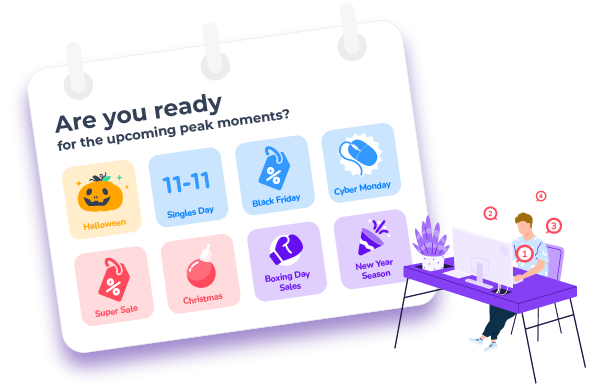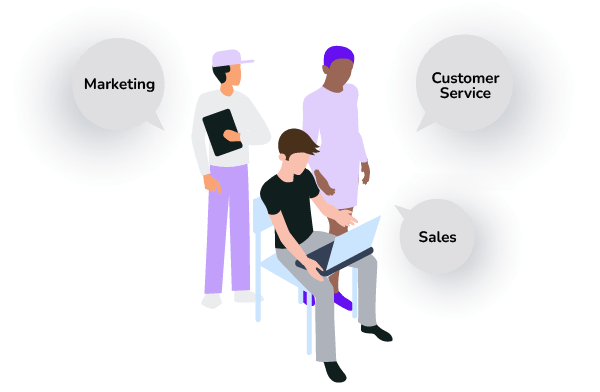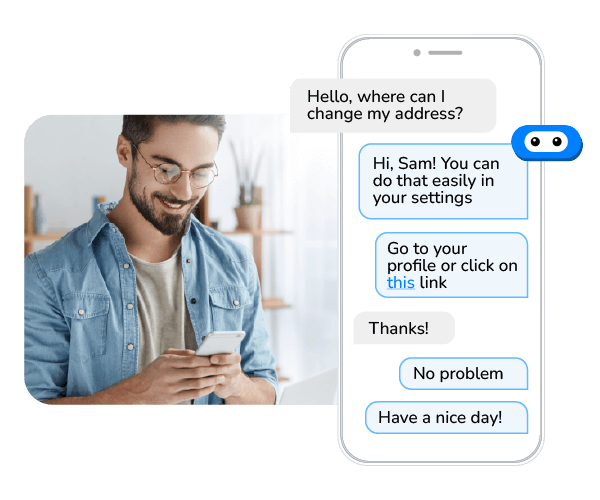- eCommerce Holiday Season: The Happiest Time of the Year?
- The Challenges for Customer Service in Q4
- 1. Holiday Season Rush: More Customers, More Interactions
- 2. Customer Interactions Across Multiple Channels
- 3. Long Waiting Times Means Frustrated Customers
- 4. Consistent and Reliable Customer Service
- 5. Working Together as Departments
- Solutions for Customer Service During Q4
- 1. Integrating Channels for Better Customer Journeys
- 2. Automate to Increase Capacity
- 3. Bring Customer Service, Sales, and Marketing Together
- 4. Look Back, Because Past Experiences Are Valuable
- Go For Smooth-Flowing Customer Service All Year Round
Q4 may seem too far in the future to consider, but planning needs to start to make the most of the critical season. In this blog, we'll share how to prepare, keep customer service at the best level possible and dive into solutions and challenges that deserve your attention.
eCommerce Holiday Season: The Happiest Time of the Year?
As any customer service agent knows, the happiest time of the year can feel stressful. Why? In a well-run retail and eCommerce organization, most orders go from a shopping basket to the customer’s doorstep without incident. Even a higher volume of service interactions can be dealt with by matching capacity with humans or chatbots. The real problem stems not only from increased volume but also from increased complexity and consumers that expect more and more.

As our research shows, service is led by emotions, which can run high during peak moments. And that is challenging. This blog's tips and solutions can help prepare your customer service for Q4 and the year-round. We'll start with the challenges and then look into solutions and recommendations.
The Challenges for Customer Service in Q4
1. Holiday Season Rush: More Customers, More Interactions
Let’s start with the most obvious one: the sheer busyness of business in Q4. Even if your website and shopping scripts can handle 10x the number of customers, your customer service infrastructure may not deal with questions and returns, primarily if a large part of that backend relies on human labor. And what to do with your opening times. Does an increase in interactions means longer opening times?
2. Customer Interactions Across Multiple Channels
Each channel tends to have a different type of customer interaction. Customers chase orders with your chatbot, request product details via WhatsApp, and search for help on your website. Not knowing what each channel does best – and setting goals and expectations that make a good match – will slow both your people and your performance. Customers will use multiple channels to reach out to you. How do you tackle all these interactions? And do you know when customers expect a response when using a specific channel?

3. Long Waiting Times Means Frustrated Customers
If capacity hits a limit, one more query can disproportionately affect the entire queue – “the straw that broke the camel’s back” effect, as customers on hold redial in frustration or put in the same query on different channels. Expect more turbulence if your system doesn’t have a way of dealing with this. So look for customer service software that prevents queues and can handle the pressure.
4. Consistent and Reliable Customer Service
If the answer to a service issue has limited availability (for example, the answer lies with another customer service agent), two problems arise. First, capacity gets skewed as customers “queue” for the subject expert or resource. Second, the overall quality of service suffers since some customers will receive better resolutions than others. That’s a problem when customer service should be consistent, reliable, and without queues. Sharing knowledge is critical here and should be easy.
5. Working Together as Departments
We all know that we should work more together, as one team. But be honest - are you working together, or are there still silos keeping information blocked? If the team’s organized into “email requests” and “requests by phone,” knowledge can’t flow freely between those 'silos,' and different channels won’t have access to the same information. So collaboration can be complex, meaning customer experience depends on the channel they choose.

Solutions for Customer Service During Q4
There are multiple ways to tackle the points mentioned above: integration, automation, self-serve options, and, remember: learning from past experiences, which means connecting the data where it matters most: between sources, applications, employees, and customers.
Here are three solutions that will help you to prepare for Q4:
1. Integrating Channels for Better Customer Journeys
Since customer service is fundamentally about customers – not technology – your service infrastructure needs to work flawlessly across channels, whether they’re typing into a chatbot window, sending a text, or asking a question via WhatsApp. All relevant information is collected together and available to everyone who needs it.
So, keep the customer journey flowing. Bring different channels together in one general inbox, for example, with Mobile Service Cloud. That is how you make sure customer service issues are being dealt with in the quickest and best way possible. Every time a conversation can continue when the customer jumps channels, every time you can point to an existing FAQ from a WhatsApp message, it means a faster resolution. For customers, it just feels like you’ve got your act together. So stop wasting your customers’ time, and bring all channels and departments together.
2. Automate to Increase Capacity
Especially in eCommerce holiday season, the larger volume of queries will contain many of the same types. If each is taking (say) an hour of an agent’s time to solve the solution pathway yet is always the same, it’s worth looking for a way to automate it and make it easier. Resolution pathways can easily be automated with a chatbot or dynamic FAQ:
Save time with automation
Increase capacity
Be available 24/7
Every minute you can put back into an agent’s day saves you money – and increases your capacity in peak season. Ultimately, you are available 24/7, and questions can be solved immediately.
Tip: Integrate your current customer service software to get the most out of your data or build an AI-Chatbot to automate conversations.

3. Bring Customer Service, Sales, and Marketing Together
Remember the silos we discussed? Departments working on their own without knowing what other people are doing? That is why you should bring service, sales and marketing together and break those silos down. You can take advantage of up-sell and cross-sell opportunities by communicating with each other and ensuring that information can flow easily between departments. It is all about teamwork.
Tips on how to get started:
Look for software solutions that let you easily collaborate internally and externally
Set mutually agreed goals and metrics - focusing on the customer
Make clear what roles entail and understand how you impact each other
Integrate customer service software with marketing infrastructure
4. Look Back, Because Past Experiences Are Valuable
Learning from experience is always a good thing. But it’s beneficial during the peak shopping season. Every service interaction explains how customers are feeling or experiencing your brand.
When you’ve got connected data across channels, you can look back to past years and see where failures could be neutralized. Perhaps you made every customer happy, but it cost you dearly in human resources. Maybe you noticed queries of type A go down at busy times, but queries of type B go up massively. This will tell you where to focus your efforts to streamline your team for the busiest quarter.
Tip: Remember to analyze previous years’ data to help you prepare for Q4.
Go For Smooth-Flowing Customer Service All Year Round
Many customer service software solutions are out there – but ask yourself this: do they put your customer service agents and customers first?
At CM.com, we help customer service teams to communicate and collaborate across all channels with customers and other parties. Customer service agents deserve a solution that gives them a better overview and allows them to collaborate efficiently. So your customers and agents are happy.
So, choose the best software solutions to make the most of every minute. Bring different channels, departments, customers, and agents together in one solution with CM.com.
That is how your customer service is ready for Q4. And, of course, the whole year round.
Intrigued? Please reach out to us today.
